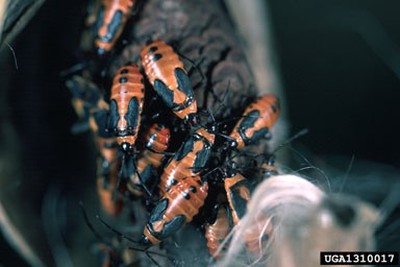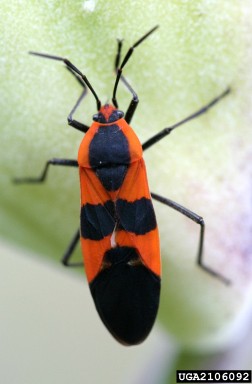Abstract
Milkweed bugs, as their name suggests, have a close relationship with the milkweed plant. The plant produces an irritating, milky sap, and toxic compounds, but somehow the milkweed bug is unaffected by them. Instead, it concentrates chemicals from the sap in its body, acquiring an unsavory taste that, along with its bright coloration, protects it from predators. Given this close relationship, will the milkweed bug exhibit a color preference for egg-laying sites? This project is designed to find out.Summary
Andrew Olson, Ph.D., Science Buddies
Sources
The project is based on:
- Jackson, K., 2007. "Determining Color Preference for Egg-Laying in Milkweed Insects," 2007 Intel International Science and Engineering Fair, Albequrque, NM.

Objective
The goal of this project is to determine whether milkweed bugs have a color preference for their egg-laying sites.
Introduction
Milkweed bugs (scientific name, Oncopeltus fasciatus), like monarch butterflies, use the milkweed plant as their major food source. The milkweed plant produces a sticky white sap and compounds called cardenolides which can be toxic because they interfere with electrical activity in the heart (Agrawal and Malcolm, 2002). Milkweed bugs are not adversely affected by the toxins. Instead, they concentrate compounds from milkweed, with the result that potential predators find the bugs to be bad-tasting (CISEO, 1997a). The distinctive orange (or orange-red) and black coloring of the milkweed bug makes it easy for potential predators to learn to avoid them (see Figure 1).

Figure 1. Adult milkweed bug. The orange and black coloring serves to warn potential predators that the milkweed bug tastes awful. (Image © David Cappaert, Michigan State University, InsectImages.org)
Since insects have an exoskeleton, they must molt (i.e., shed the exoskeleton) in order to grow. Each succesive stage of growth is called an instar. In many insects, the body changes dramatically as the insect develops from the larval instar stages to the adult. This is called complete metamorphosis. The change from caterpillars (the larval instar stages) to butterflies (the adult stage) is a good example of complete metamorphosis. Milkweed bugs undergo incomplete metamorphosis: the instar stages look much like the adult bugs, although they do not have compete wings and the color pattern is different (CISEO, 1997a). Figure 2 is a picture of immature milkweed bugs.

Figure 2. Immature milkweed bugs. Milkweed bugs undergo incomplete metamorphosis, so the immature instar stages look much like the adult stage. Immature milkweed bugs have incomplete wings and a different coloration pattern than the adult bugs. (Image © Jim Occi, InsectImages.org))
In the wild, milkweed bugs feed on the seed pods of milkweed plants. They use their proboscis to penetrate the seed pod and the seeds inside. They use salivary enzymes to digest the seeds and suck the juices back in through the proboscis (CISEO, 1979a). In captivity, milkweed bugs can be raised on sunflower seeds, which they consume in the same manner (CISEO, 1997a; MSU, 1997; LHOS, 2007).
Milkweed bugs are fairly easy to raise in captivity. Adults or eggs can be purchased from biological supply houses (see the Materials & Equipment section, below). The bugs can be housed in a plastic container or large ziploc bag, with small airholes punched in the top. You need to supply water (a bottle with an immersed cotton wick protruding from the top), and food (sunflower seeds). To make the artifical habitat more interesting, you can also provide a branch for the bugs to climb on, and you can hang a bundle of seeds from this.
When adult milkweed bugs mate, they face away from each other and attach end-to-end, sometimes for 30 minutes or more (CISEO, 1997a). A few days to two weeks later, the females will lay their eggs. In an artificial habitat, the females will lay eggs on cotton wick material that you provide. This project asks the question, do milkweed bugs have a color preference for egg-laying sites? Due to their intimate association with the milkweed plant, one might suppose that they would prefer green substrates. Is this in fact the case? You can test this hypothesis by providing cotton wicks dyed different colors, and testing to find out if any color attracts more eggs than the others.
Terms and Concepts
To do this project, you should do research that enables you to understand the following terms and concepts:
- Milkweed bugs
- Instar
- Nymph
- Molt
- Metamorphosis
- Proboscis
- Milkweed plants
- Insect color vision
Questions
- How do you identify male and female milkweed bugs?
Bibliography
- For background information on milkweed bugs, including tips on how to identify adult males and females and how to care for the bugs in captivity, see these websites:
- CISEO, 1997a. Milkweed Bug Information, Center for Insect Science Education Outreach, University of Arizona. Retrieved May 28, 2007.
- CISEO, 1997b. Milkweed Bug Rearing, Center for Insect Science Education Outreach, University of Arizona. Retrieved May 28, 2007.
- LHOS, 2007. Milkweed Bugs, Lawrence Hall of Science, University of California. Retrieved May 28, 2007.
- MSU, 1997. O. Orkin Insect Zoo: Arthropod Care Directory: Milkweed Bugs, Mississipi State University. Retrieved May 28, 2007.
- These webpages have information on color vision in insects:
- Ross, M., 2005. Insect Color Vision, A Moment of Science, Indiana University. Retrieved May 28, 2007.
- Meyer, J.R., 2006. Color Vision, Department of Entomology, North Carolina State University. Retrieved May 28, 2007.
- Kimball, J.W., 2004. The Compound Eye, Kimball's Biology Pages. Retrieved May 28, 2007.
Materials and Equipment
To do this experiment you will need the following materials and equipment:
- 24-30 adult milkweed bugs (half male, half female):
- If there are milkweed bugs in your area, you can collect them yourself in late summer or early fall (CISEO, 1997a; CISEO, 1997b)
- You can order adult milkweed bugs from Carolina Biological Supply Company catalog #143814.
- Plastic container for test apparatus
- 5 Pieces of cotton wick material, each at least 3 cm long
- Food coloring
- Large Ziploc® bag (or other suitable container) for housing bugs
- Common pin (for poking air holes in bag)
- Water source (need details)
- Food source for bugs: you can use shelled sunflower seeds or you can order it from an online vender like Carolina Biological catalog #143830.
Disclaimer: Science Buddies participates in affiliate programs with Home Science Tools, Amazon.com, Carolina Biological, and Jameco Electronics. Proceeds from the affiliate programs help support Science Buddies, a 501(c)(3) public charity, and keep our resources free for everyone. Our top priority is student learning. If you have any comments (positive or negative) related to purchases you've made for science projects from recommendations on our site, please let us know. Write to us at scibuddy@sciencebuddies.org.
Experimental Procedure
-
First, make an artificial habitat for the milkweed bugs (LHOS, 2007):
- "Culturing milkweed bugs is fairly easy. The bugs require no soil or green plant material. Just about any container is suitable for a habitat. Because milkweed bugs can walk on any surface, including smooth plastic, glass, metal, wet surfaces, and all textured surfaces, the habitat must be closed tightly, and the ventilation holes must be tiny so the first instar nymphs can't escape.
- "We suggest a plastic zip bag for the habitat container. Use a pin to poke a hundred holes in the bag, and install a water container in the bottom. To add interest, put a branch in the bag and attach a bundle of raw, shelled sunflower seeds and a cotton ball to the branch. Hang the bag from a paper clip next to a wall out of direct sunlight.
- "Maintenance is minimal. Keep an eye on the water level, and when it gets low after 3-4 weeks, add water and perhaps replace the wick. A new bundle of 20 to 30 sunflower seeds each month should be adequate for a modest culture of 25 bugs. The culture may start to look a little messy after a month as little brown spots of waste appear on the walls of the bag and the molts start to accumulate. Transfer the branch, water fountain, and bugs to a new bag to renew the aesthetic appeal of the culture." (LHOS, 2007)
-
Use food coloring to dye the wick material.
- Soak each of four cotton wick pieces in water with food coloring added. Use separate containers for each color (yellow, red, green, blue).
- Squeeze out the excess dye, then allow the wicks to dry.
- Leave one wick undyed (white).
- Cut the wicks into 1-cm lengths for testing milkweed bug color preference.
-
Watch your new cultures for several days, checking the wick inside to look for the presence of eggs.
- Once you see that your cultures are reliably laying eggs each day, then you are ready to start your experiment.
- Be sure that you know what the eggs look like so that you know how to find the eggs and that you can count them.
- Set up a separate test container with water and food source (as for your usual habitat), also add one of each of the five colors of wick material.
- Place bugs in container for a set time period (e.g. 24 hours).
- Count the number of eggs on each color of wick material.
- Repeat steps 3-5 so that you have at least three different tests, randomizing the order of the wick colors in the bag each time.
- Make a table of your results for each trial, showing the number of eggs laid on each color of wick material. Did the bugs show any consistent color preference for egg-laying sites?
Ask an Expert
Global Connections
The United Nations Sustainable Development Goals (UNSDGs) are a blueprint to achieve a better and more sustainable future for all.
Careers
If you like this project, you might enjoy exploring these related careers:








